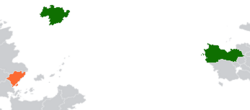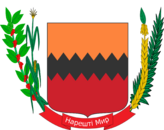Soravia-Vinalia relations: Difference between revisions
| Line 133: | Line 133: | ||
=== Vinalian missions in Soravia === | === Vinalian missions in Soravia === | ||
* Samistopol (embassy) | * [[Samistopol]] (embassy) | ||
* Patovatra (consulate-general) | * [[Patovatra]] (consulate-general) | ||
* | * [[Novokharbatsk]] (consulate) | ||
* Luchintsy (consulate) | * [[Kholmogory]] (consulate) | ||
* [[Luchintsy]] (consulate) | |||
[[category:Vinalia]] | [[category:Vinalia]] | ||
[[category:Soravia]] | [[category:Soravia]] | ||
Latest revision as of 11:19, 24 July 2023
This article is incomplete because it is pending further input from participants, or it is a work-in-progress by one author. Please comment on this article's talk page to share your input, comments and questions. Note: To contribute to this article, you may need to seek help from the author(s) of this page. |
 | |
Soravia |
Vinalia |
|---|---|
| Diplomatic mission | |
| Soravian Embassy, Vinalinsk | Vinalian Embassy, Samistopol |
| Envoy | |
| Ambassador Ivan Okhmatov | Ambassador Sidor Bagrationi |
Soravia-Vinalia relations (Soravian: Відносини між Зоравський Pеспубліка та Об'єднана Республіка Віналія; Vidnosyny mizh Zoravs'kyy Respublika ta Ob'yednana Respublika Vinaliya) are the bilateral relations between the Soravian Republic and the Unified Republic of Vinalia. The history of both countries began with the exploration and claim by Soravian explorer Afanasij Orlev of all lands north of the Medvid River for the Soravian Empire.
Vinalia was established as a separate colony than Chistovodia, owing to the noted differences between the indigenous communities of Vinalia and Chistovodia. Vinalia became an agricultural center for Soravia, exporting cash crops for Soravian consumption. Vinalia won its independence during the Chistovodian War of Independence, where Vinalia joined Chistovodia as a federal state, earning its full independence in 1885. Soravia and Vinalia maintained cordial relations, as Soravia was an important trading partner for Vinalia. The First Vinalian Civil War in 1933-1935 saw Vinalia split into two countries, the Democratic Republic of Vinalia, and the Councilist People's Republic of Vinalia. Soravia maintained ties with the Republic of Vinalia during this period. Soravia and both Republics experienced great rapprochement during the early 90's as Soravia returned to prominence in Asteria Superior, helping both republics reunify in 1993, and becoming a close partner to Vinalia. Since reunification, Soravia and Vinalia have had a healthy relationship based on their historic, cultural and linguistic ties, with Soravia being Vinalias 2nd largest trading partner.
Country comparison
Historical relations
Colonial Era (1568 - 1863)
Part of Chistovodia and Independence (1863 - 1935)
Split Vinalia (1935 - 1993)
Unified Vinalia (1993 - )
- Vinalia struck a major deal in 1996 with Soravia. The Soravian-Vinalian Friendship deal established vast cooperation schemes between both countries. The Vinalian Mining Sector fell increasingly under foreign control with Soravian firms being allowed access to previous Government owned mining corporations, Soravian companies began operating factories and employing Vinalian workers. Most prominently the Soravian state-owned oil company Dernafkom began exploration and cooperation with the Vinalian state-owned Voliya Oil Company, helping in the establishment of the Vinalian Petrochemical sector.
Culture
Film
Literature
Music
- Euclean artists primarily those from Soravian holding large followings in the nation
Art
- Catherine Beaumonoirs travels to Asterias in 1839, became a watershed moment for Vinalia as it cemented realism at the forefront of Vinalian art. Dario Salino, became Vinalias most renown painter in 1640, a close associate of Catherine Beaumonoir,
Economic cooperation

- The privatization of former North Vinalian state owned enterprises has only increased the power of mineral conglomerates, with the Soravian majority owned United Vinalian Uranium Company (Об'єднана віналійська уранова компанія; Ob'yednana vinaliysʹka uranova kompaniya) controlling 78% of Vinalian Uranium production, and 83% of its known reserves.
- Vinalia operates mainly with Soravian airlines for trans-oceanic flights into Euclea
- In 2017, Vinalia was visited by up to 8.7 million tourists, mostly from Soravia,
- Vinalian wines are highly sought after specially in Soravia where Vinalian wine is seen as a commodity.
Trade
Military cooperation

Vinalia acquired 12 G-7 aircraft from Soravia in 2021, along with numerous missiles and parts.
Resident diplomatic missions
Soravian missions in Vinalia
- Vinalinsk (embassy)
- Orlavo (consulate-general)
Vinalian missions in Soravia
- Samistopol (embassy)
- Patovatra (consulate-general)
- Novokharbatsk (consulate)
- Kholmogory (consulate)
- Luchintsy (consulate)



